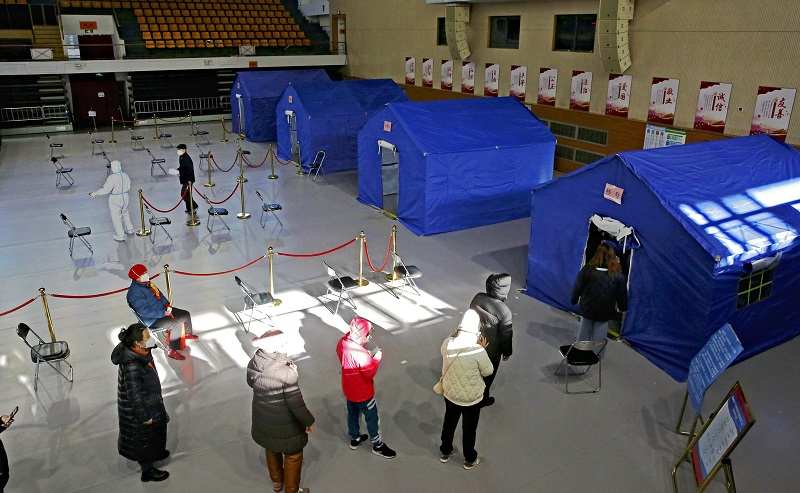
People line up to enter a fever outpatient tent set up in a gymnasium in Beijing on Monday.
17:19 JST, December 20, 2022
SHANGHAI/BEIJING — Novel coronavirus infections are spreading rapidly in China following Beijing’s altering of the nation’s zero-COVID policy designed to contain the disease. The Chinese government puts the number of COVID-related deaths for December at four as of Sunday, but the figure clearly does not reflect the actual situation.
The death toll appears to be rising sharply, with one estimate saying that COVID-related deaths in the nation could reach nearly 1 million.
That estimate is based on a study by University of Hong Kong researchers including Gabriel Leung, an honorary professor and the university’s former medical faculty dean, as reported in Hong Kong’s main English-language newspaper, the South China Morning Post.
The researchers estimated that the COVID-related mortality rate will rise to 684 per million people following the relaxation of zero-COVID restrictions if China does not put in place sufficient infection control measures, such as a large-scale fourth-dose vaccination rollout. Based on the rate, the Hong Kong newspaper estimated Thursday that China, with a population of about 1.4 billion, could face about 965,000 deaths.
The study pointed to the possibility that China’s medical system will be overwhelmed if the relaxation of COVID restrictions proceeds without taking adequate public health and social measures.
Wu Zunyou, chief expert of epidemiology at the Chinese Center for Disease Control and Prevention, said Saturday that this winter’s coronavirus infection rate would be around 10% to 30%, with the mortality rate estimated to be between 0.09% and 0.16%.
Using these rates means up to 420 million people could be infected and approximately 672,000 people could die.
The Chinese government announced Monday that the cumulative number of COVID-related deaths as of Sunday stands at 5,237. On that day, for the first time in about two weeks, two deaths were reported. This is another number that does not seem to reflect the actual situation, however.
The next afternoon at a funeral home in Beijing, there was a line of more than 30 cars carrying bereaved family members.
A staff member at a crematorium told The Yomiuri Shimbun by phone: “We usually have about 30 cremations a day, but recently, we are having more than 100 every day. The spread of the infection is likely one of the causes.”
Vaccination concerns
The Chinese government announced a drastic easing of zero-COVID restrictions on Dec. 7, cancelling strict travel restrictions and large-scale PCR testing to identify and isolate infected people. Since then, the virus infection has spread rapidly, and outpatient fever clinics in large cities like Beijing have been flooded with patients.
Eight tents are set up in a gymnasium to serve as a temporary fever clinic in Beijing’s Xicheng District, where the coronavirus infection is spreading quickly. On Monday, staff members in protective clothing were responding to residents seeking treatment.
“Give me some medicine,” said a person who looked visibly distressed.
Ahead of the Lunar New Year holidays, which next year falls in late January, when many workers in urban areas return to their hometowns, the central government is urging local governments to promote elderly people’s COVID-19 vaccination and to strengthen the medical system in rural areas. However, it is unclear whether effective measures can be taken.
In China, only about 66% of people ages 80 and over have been vaccinated. Many people are refraining from getting a COVID-19 vaccination over fears of adverse reactions, such as fever.
Hong Kong’s Ming Pao newspaper on Monday pointed out the likelihood that the vaccination rate in China’s rural areas are lower than that of the national average. It urged that word must be spread about the necessity of COVID-19 vaccinations in rural areas and personnel should be dispatched to carry out vaccinations as soon as possible.
Concerns also remains over the quality of Chinese vaccines, considered to have lower efficacy compared to vaccines developed by companies in the United States and Europe. As only Chinese vaccines are being used, even if the vaccination rate increases, it remains to be seen whether that will lead to protection against infection and prevention of the onset of serious symptoms.
"World" POPULAR ARTICLE
-

8 Japanese Nationals Stranded on Indonesia’s Sumatra Island
-

Mozambican Cooking Class Held in Matsuyama, Ehime Pref.; Participants Don Aprons, Bandanas Made from Traditional Mozambique Fabric
-

China to Impose Sanctions on Shigeru Iwasaki, Former Head of Japan’s Self-Defense Forces, Who Serves as Adviser to Taiwan’s Executive Branch
-

U.S. Senate Resolution Backs Japan, Condemns China’s Pressure
-

South Korea’s Top Court Dismisses Nippon Steel Appeal in Lawsuit over Requisitioned Worker
JN ACCESS RANKING
-

Keidanren Chairman Yoshinobu Tsutsui Visits Kashiwazaki-Kariwa Nuclear Power Plant; Inspects New Emergency Safety System
-

Imports of Rare Earths from China Facing Delays, May Be Caused by Deterioration of Japan-China Relations
-

Tokyo Economic Security Forum to Hold Inaugural Meeting Amid Tense Global Environment
-

University of Tokyo Professor Discusses Japanese Economic Security in Interview Ahead of Forum
-

Japan Pulls out of Vietnam Nuclear Project, Complicating Hanoi’s Power Plans























